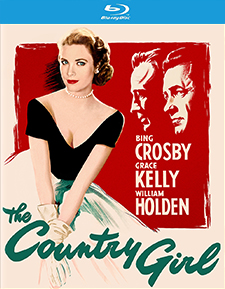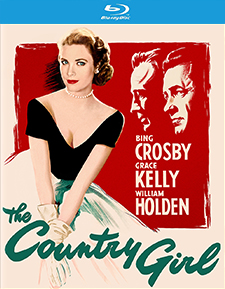Country Girl, The (Blu-ray Review)

Director
George SeatonRelease Date(s)
1954 (July 9, 2024)Studio(s)
Perlberg-Seaton Productions/Paramount Pictures (Kino Lorber Studio Classics)- Film/Program Grade: A-
- Video Grade: A
- Audio Grade: A
- Extras Grade: B
Review
One of the biggest controversies in Academy Award history is the Best Actress Oscar won by Grace Kelly for The Country Girl over Judy Garland’s comeback triumph in A Star Is Born. It was interesting to revisit this 70-year-old film to check out Kelly’s performance and try to figure why the film lacks the enduring profile of many of its contemporaries.
Successful Broadway director Bernie Dodd (William Holden, Sunset Boulevard) is under pressure to replace his lead actor after a week of rehearsals. Dodd wants Frank Elgin (Bing Crosby, Going My Way) for the lead. Knowing Elgin’s reputation as a washed up alcoholic no longer capable of carrying a show, producer Philip Cook (Anthony Ross, Between Midnight and Dawn) is furious. Insisting that Elgin is the best performer for the role and off the sauce for good, Dodd ultimately prevails.
It soon becomes clear that Elgin is completely dependent on his considerably younger wife, Georgie (Kelly, Dial M for Murder), for moral support and to make decisions for him. Dodd sees the relationship as troublesome for the play and detrimental to Elgin, and attributes his decline to Georgie. Elgin, however, insists that his wife depends on him and he could never leave her. Georgie accompanies him to rehearsals, makes demands on his behalf, and gets under the skin of both Dodd and Cook. Elgin soon succumbs to the pressure of starring in a major Broadway production and starts to drink again, creating dramatic confrontations among Dodd, Georgie, and Elgin.
Based on the 1950 play by Clifford Odets, which did not contain music, The Country Girl is a backstage drama that pits the weaknesses and strengths of three explosive characters against each other. In deference to Crosby, the play was adapted as a musical, with songs written by the champagne team of Harold Arlen and Ira Gershwin. Crosby gets to sing three numbers, one a production number from the show within the film. The crooner handles these songs in the expert, laid-back style we remember from his movie musicals. But it’s the dramatic scenes that stand out.
Crosby is thoroughly convincing as the actor who puts on a confident face for the director and cast but becomes an emotional wreck with his wife. Later, when Elgin resumes drinking, Crosby avoids a stereotypical drunk performance in favor of a quieter, more restrained portrait of a man in deep pain. With his peak film years in musicals well behind him, The Country Girl was an opportunity for the singer to reveal an untapped talent for serious drama and he’s more than up to the task.
Holden is forceful and dynamic as Dodd. He’s confident, sometimes overbearing, and combative when he wants something. There’s a key scene in which Dodd learns that much he was told and had assumed about the Elgins is untrue. With that realization, Holden must, on camera, change his character’s expression from contempt and anger to empathy, and he does so admirably. Holden often hasn’t been given his due as an actor, but he’s in top form here.
Kelly, who made only eleven films before becoming the Princess of Monaco, turns in a memorable performance as the long-suffering, supportive wife. With make-up, hair style, and costumes playing down her beauty to make her look older and dowdy, she plays the complexities and vulnerabilities of Georgie with equal skill. In a brief scene after the denouement, not only has her appearance become more vibrant, but her posture and walk are more confident, almost as if the ordeal with her husband, the play, and Dodd have strengthened her. She delivers her dialogue without overemphasis, allowing the power of Odets’ words to be felt. In several scenes, she underplays, allowing either Holden or Crosby to be the focus. There’s definite chemistry between her and Crosby, and her performance as wife/mother/confidante/shoulder-to-lean-on is sympathetic and multi-faceted.
George Seaton’s script is powerful and reflects Hollywood’s attempt to deal with substantial stories in the face of competition from TV. The three main characters are all flawed in one way or another and all are powerful. Without a typical leading man or leading lady, we accept that these are real people. Seaton offers no visual pyrotechnics or unusual shots, relying on the material to captivate, and it does. The three stars turn in exceptional performances.
In an otherwise first-class film, there’s one scene toward the end of the film that seems to come out of nowhere. Accompanied by loud musical punctuation from Victor Young’s score, the scene asks us to accept a development that isn’t true to the characters and seems an awkward contrivance. In a narrative that, up to this point, moves logically, the scene is a jarring weakness. Fortunately, this scripting hiccup isn’t enough to derail the film.
Movies about putting on a show abound. 42nd Street, All About Eve, The Band Wagon, and The Producers all focus on the difficulties of mounting a Broadway show, but The Country Girl uses the setting for a larger story about a mutually dependent couple and an outsider who disrupts their balance. The story could have been set in an office, a factory, or a suburban neighborhood, but the pressure of putting a professional show together on a tight schedule adds tension and glamour. Making it a musical offers Crosby a chance to sing a few songs, though the show, called The Land Around Us, seems a hokey Oklahoma! wannabe.
The Country Girl was shot by director of photography John F. Warren on 35 mm black & white film with spherical lenses and presented in the negative aspect ratio of 1.37:1 with an intended aspect ratio of 1.85:1. The Blu-ray from Kino Lorber Studio Classics features a 2023 HD Master by Paramount Pictures taken from a 4K scan with an aspect ratio of 1.66:1. Contrast and clarity are excellent. Details are nicely delineated in the rehearsal stage with makeshift furniture, decor in the Elgins’ dingy apartment, theater marquee, backstage equipment, and costumes in The Land Around Us number. A few stock footage shots of a Broadway street with illuminated theater names establish the New York location. Make-up intentionally downplays Grace Kelly’s beauty, giving her a gray, nondescript look. Crosby is shown in his dressing room taking off hair pieces and darkening the gray in his hair.
The soundtrack is English 2.0 DTS-HD Master Audio. Optional English SDH subtitles are available for the main feature. Dialogue dominates this story and it’s recorded clearly, with every word easily understood. Victor Young’s score often tries a bit too hard, but the songs by Harold Arlen and Ira Gershwin are nice fits for Bing Crosby, especially You’ve Got What It Takes, which brings back tragic memories for Elgin. Crosby’s duet with club singer Jacqueline Fontaine on Love and Learn Blues is a jazzy, upbeat number like Cole Porter’s Now You Has Jazz from High Society, another Crosby/Kelly movie.
Bonus materials on the Region A Blu-ray release from Kino Lorber Studio Classics include the following:
- Audio Commentary by Jason A. Ney
- Trailer (2:41)
- Come Back, Little Sheba Trailer (2:25)
- Road to Utopia Trailer (2:15)
- High Noon Trailer (1:37)
- The Bridges at Toko-Ri Trailer (2:00)
- The Counterfeit Traitor Trailer (3:23)
Audio Commentary – Professor and film scholar Jason A. Ney provides a thoroughly researched overview of The Country Girl, the film’s Blu-ray debut. The action takes place mostly in New York’s Longacre Theater, tied in with Babe Ruth’s trade from the Boston Red Sox to the New York Yankees and the 86-year Curse of the Bambino because the theater’s owner also owned the Red Sox and needed money to continue mounting shows. Director George Seaton changed Frank Elgin from a dramatic actor to a singing actor because it was assumed audiences would want to hear Bing Crosby sing. Ney provides an extensive look at how alcoholism has been depicted in movies, starting with Charlie Chaplin’s broad portrayal in the silent era. Drinking was treated either as comedy or as over-the-top exploitation. The Lost Weekend dealt with it as an addictive sickness. Movies about alcoholics are often called “Oscar bait” because they frequently result in Academy Award nominations. At the beginning, director George Seaton films Crosby with long, uninterrupted takes and little on-screen movement because he knew Crosby could hold the audience. William Holden leans into the intensity and nastiness of Bernie but also conveys the genuine concern for Frank that leads Bernie to takes both a personal and financial risk in hiring him. In Georgie’s first appearance, she looks weary and unglamorous. Edith Head was enlisted by Paramount to costume Grace Kelly to make her look frumpy and older than her years. Kelly wore sweaters and shapeless dresses. In addition, bags were placed under her eyes and she was given an old-lady hairstyle. Crosby was 27 years older than Kelly at the time. Both were cast against type. Georgie and Bernie base their views of men and women on their own experiences. Crosby’s performance hits the audience in the heart, whether he portrays degradation or a man struggling to get back to work. His Frank is called the actor’s “most raw and powerful screen performance.” The musical sequences are an emotional breather from the story of deeply damaged people. The songs also serve as a chasm between the idealized world they envision and the actual depression of Frank’s life. For the screen adaptation, profanity had to be removed, secondary characters eliminated, and relentless focus placed on the three main characters. In addition, Frank is made more timid and insecure than in the play. A flashback clarifies Frank’s long suffering and delivers greater emotional heft than hearing about it through dialogue. In talking about Crosby’s career, Ney says that 41 of his records hit Number 1, and from the 1930s through the 1950s, he landed on the list of top box office earners five times. In assessing reasons for the overlooked status of The Country Girl, Ney cites its bitter tone, cynicism, limited visual palette, and lack of a name director. It also might have to do with the fact that 1954 was a banner years for all three actors, each making a number of top films that may have overshadowed The Country Girl. The Country Girl is an “unflinching perspective” on how alcoholism can not only destroy the addict but those close to him, as well as how some marriages require work to survive. In conclusion, Ney states that The Country Girl “is ready for re-discovery.”
The Country Girl is notable for the atypical roles played by Grace Kelly and Bing Crosby. Both actors turn in high-quality performances that do justice to Odets’ characters. The film was nominated for seven Academy awards including Best Actor (Crosby) and Best Picture. In addition to Kelly’s win for Best Actress, the Best Screenplay Adaptation Oscar went to George Seaton. Grace Kelly had a really good year in 1954. In addition to The Country Girl, she appeared in the Hitchcock films Dial M for Murder and Rear Window.
- Dennis Seuling

